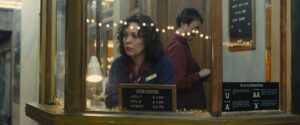When you cross a Coen Brother screenplay with a race-relations subplot set in the 1950s, things are bound to get a little interesting. However, in the case of Suburbicon, this intrigue is also accompanied by confusion and befuddlement. Director George Clooney fails to merge two majorly disparate plot-lines, and what ensues is a perplexing combination of murder mystery and social commentary, redeemed only slightly by the performances of an A-list cast.
Suburbicon opens on Oct. 27 and stars Matt Damon as Gardner Lodge—a successful executive living with his young son Nicky (Noah Jupe) and wife Rose (Julianne Moore). In accordance with the atmosphere of the film and the Coen Brothers’ style, there are peculiarities to the Lodge family that are deeply unsettling. Rose is confined to a wheelchair as a result of a car accident that happened when Gardner was driving. Margaret (also played by Julianne Moore), Gardner’s sister-in-law, is constantly hovering and simpering in the background. This feeling of undefinable peculiarity extends beyond the Lodge family and to the whole town of Suburbicon, which is filled with pleasant neighborhoods of brightly colored houses and neat streets on the surface.
It doesn’t take long for things to start going awry in this idyllic suburb. The film jumps immediately to a crime scene in which a pair of “robbers” have tied up the Lodge family and forced them to inhale chloroform. The pacing is strange and drawn out, and the pulsing music is almost unbearable. Though the rationale behind the eccentricity of the scene is later revealed, the scene’s placement in the first few minutes of the film is nonetheless a very unexpected choice.
As the Lodge family is facing their dramatic ordeal, the residents of Suburbicon are violently protesting the arrival of a new African-American family, the Myers, that has moved there from Washington D.C. One initially believes that the film will delve into the details about the Myers, especially since they are based on a real family that moved to Levittown, PA in 1957. However, the audience never even learns the names of the mother and father.The Myers are simply a parallel narrative in the context of the whole film. The only tie between them and the Lodges is their proximity to each other (they are next-door neighbors) and the bond that their two young sons form.
The focus on the racist mobs congregating outside of the Myers’ house is clumsily diverted to the hospital, where Rose Lodge has died. Margaret, who seems questionably devoid of grief, sticks around after her sister’s passing because, and this line is repeated throughout the film, “Nicky needs a mother.” Everyday life for Nicky becomes increasingly suspicious after the funeral. Though only around 10 years old, Nicky begins to pick up on the inconsistencies and abnormalities surrounding his mother’s death. Dark details are revealed when Roger (Oscar Isaac), an inspector for insurance claims, visits the house.
What ensues after Roger’s visit is a series of distressing and violent events. A shot of Matt Damon slowly pedaling away on his son’s small bike (training wheels included) with a shirt and glasses splattered with blood after depositing a body in the dumpster is so ridiculous that it brings an unintended laugh to the viewer’s throat. These moments reveal the genius of the Coen Brother’s screenplay, and the talent of the cast. Damon does a riveting job of portraying the inexperienced and unsuccessful mastermind, and Moore is able to give Margaret an unplaceable characteristic that is extremely irksome to the audience. Jupe is fairly impressive for his age, and there is a steely-eyed determinism to his performance that gives little Nicky a surprising amount of depth and resolve.
If the murder mystery portion of the film is so well-done, why have many of the early reviews of Suburbicon been so negative? The answer lies in Clooney’s over-ambition and inability to reconcile two storylines (Clooney added to the Coen Brothers’ original screenplay).The inclusion of the story of the Myers, though well-intentioned, feels tone deaf. Because we are given almost no background information, the Myers are representations and symbols of those subject to the horrors of racism and discrimination instead of not well-defined and complex characters. It’s not clear what Clooney is attempting to portray with his subplot, but if he is pointing out how bad things were “back then” in the 50s, it seems a little ironic in the current context given the many instances of racially-charged conflict we have seen in the past few years. Perhaps he is trying to compare the struggles of the two families and the different forms of brutality they both face. If this is the case, then his vision is even more of a misfire.
Suburbicon is the perfect example of an overambitious directorial agenda. It’s very difficult to add a parallel storyline that focuses on race relations to an already complex tale of a murder mystery. While some films like Get Out have successfully merged these two elements, Suburbicon fails spectacularly. The end result of this bizarre combination is a hodgepodge of dramatic plotlines that leaves viewers with conflicting and disquieting feelings in their guts.




